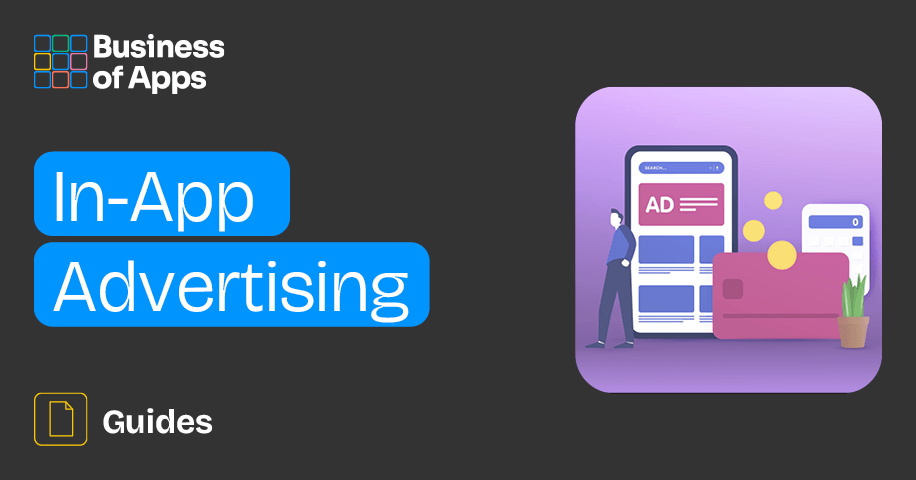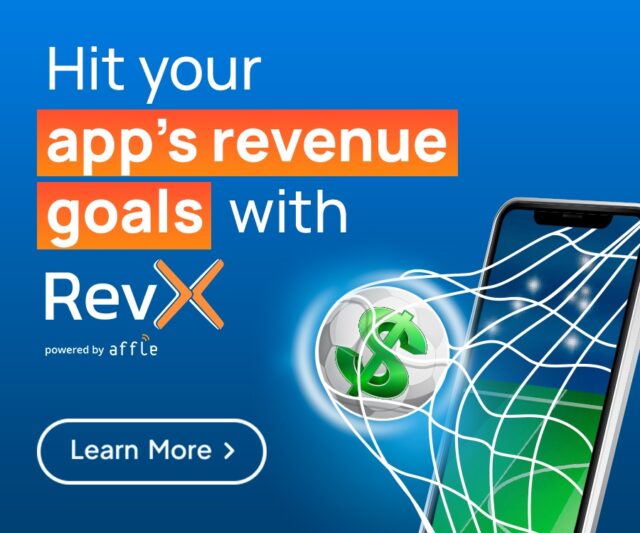
In-app advertising, IAA for short, plays a significant role in the mobile app ecosystem as one of the most common methods for app monetization, and it serves as a powerful tool for user acquisition for marketers and advertisers alike. With a staggering 5.25 billion mobile users worldwide as of 2023, having a well-defined mobile advertising strategy has become a necessity. What’s more, as the time mobile users spend in-app continues to grow, IAA is becoming an integral part of any comprehensive mobile marketing strategy worth its name. And the numbers speak for themselves—the in-app advertising market is projected to reach $314.5 billion in 2023.
Although the average smartphone user is likely familiar with in-app advertising from a consumer perspective, understanding the intricacies of displaying ads within apps can be quite challenging. In this guide, we will delve into the mechanics of in-app ads, explore how to use them effectively, and provide real-world examples and best practices to help advertisers make the most of in-app advertising opportunities.
What is in-app advertising?
In-app advertising refers to the practice of displaying paid advertisements within a mobile app, allowing app owners to capitalize on their real estate by selling ad space to advertisers. On the other hand, advertisers benefit by showcasing their ads to a relevant and engaged audience within popular mobile apps.
However, there’s way more to in-app advertising than meets the eye. With the increasing number of apps vying for a share of the advertising market, users are often exposed to numerous ads, which can lead to a negative user experience. The key to mastering IAA lies in engaging users and enhancing their overall app experience by delivering the right ad, in the right format, at the right time. Achieving this requires a deep understanding of your target audience and the ability to strike a delicate balance between promotional content and user experience. So, how do you go about doing just that?
App Revenue Buyer's Guide
Download the App Revenue Buyer’s Guide today and start shaping the future of your app! Your journey towards app monetization mastery begins now.
How does in-app advertising work?
In-app advertising involves multiple players collaborating in an automated, online process to deliver ads to mobile app users. These key players include advertisers, app publishers, supply-side platforms (SSPs), and demand-side platforms (DSPs).
The in-app advertising ecosystem
Here is an overview of how in-app advertising works and the role of each player in the process:
Advertisers
Advertisers are responsible for identifying their target audience, creating compelling ad content (ad copy + images), bidding for in-app ad space, and managing campaigns according to their targeting strategies and budgets.
App publishers
On the other side, app publishers own the mobile applications where the ads are displayed. App publishers, therefore, have the power to choose which ads to display in their apps and when to display them as well as decide the cost for each ad to maximize in-app advertising revenue.
Supply-side platforms (SSPs)
A supply-side platform (SSP) is a platform for app publishers to offer their advertising inventory to advertisers. SSPs purchase ad space from multiple publishers through a single platform and then offer their advertising inventory to a wide range of advertisers, making it easier for marketers to reach a larger and more diverse audience.
Demand-side platforms (DSPs)
Demand-side platforms (DSPs), on the other hand, serve as intermediaries between advertisers and app publishers, enabling advertisers to bid for and purchase ad space across multiple ad networks. DSPs also provide the tools and technologies that help match the right ad with the right app audience.
The IAA process
Once an advertiser creates an ad campaign, the DSP will use data analytics and algorithms to target the ad to the right audience by selecting the most relevant apps and users.
The ad is then displayed within a relevant mobile app. If the user engages with the ad and takes the desired action, the advertiser is informed, who then uses this data to optimize their campaigns, often with the support of a mobile measurement partner.
IAA in action
The advertiser pays the publisher for each impression/user interaction the ad gets. This cycle repeats for every ad impression and each app user.
IAA targeting
Precise targeting is a critical aspect of any successful mobile ad campaign. Various parameters influence the type of audience that a mobile ad will reach. These metrics include demographics, geolocation, time of day, device type, operating system, internet connection type (wifi vs. mobile), and user interests and habits.
To create an effective mobile ad campaign, advertisers must define the specific mobile users they want to reach. Building a highly accurate mobile audience profile leads to more precise ad campaign targeting. The ideal audience profile should include information such as users’ location, gender, age, mobile device preferences, and their interests and behaviors expressed on social media platforms like Facebook, Twitter, or Google.
Key data
At a glance:
- Ad spending in the in-app advertising market is projected to reach US$314.50bn in 2023.
- Ad spending is expected to show an annual growth rate (CAGR 2023-2027) of 10.10%, resulting in a projected market volume of US$462.20bn by 2027.
- The average ad spending per mobile internet user in the in-app advertising market is projected to amount to US$60.24 in 2023.
- In global comparison, most ad spending will be generated in China (US$119.10bn in 2023).
Source: Statista
The mobile app industry has come a long way in the last decade. Apps are now a fundamental part of everyday life for communication, entertainment, retail, gaming, dating and so much more.
Today, there are millions of apps available across mobile devices, and users are spending increasingly more time in-app. In fact, according to eMarketer, 88% of mobile usage time is now spent in-app. What’s more, consumers are now spending an average of 5.5 hours per day using apps on their smartphones, which brings additional opportunities for publishers and marketers alike.
It’s no surprise then that mobile ad spend is on the rise. According to the latest data from Statista, mobile advertising spending will amount to nearly 399.6 billion by 2024.
Mobile advertising spending worldwide from 2007 to 2024
Data also suggests that by 2024, US mobile ad spending alone is set to hit $167 billion, though it remains to be seen what the actual number will be.
US mobile ad spending, 2019-2024 ($billion)
Source: eMarketer
In terms of formats, display and search account for the largest shares of mobile ad spending in the US, as you can see from the table below. It’s also worth noting that US advertisers consistently spend almost a quarter of their mobile ad budgets on video, with a sizeable portion being allocated to video ads on social networks like Facebook, Instagram, TikTok, and Snapchat.
US mobile ad spending share by format (2019-2024)
| 2019 | 2020 | 2021 | 2022 | 2023 | 2024 | |
| Search | 38.2% | 37.5% | 37.4% | 37.2% | 37.0% | 37.2% |
| Display | 57.3% | 57.9% | 58.3% | 58.8% | 59.1% | 59.1% |
| -Banner ads | 28.1% | 28.0% | 27.9% | 28.0% | 27.9% | 27.1% |
| -Rich media | 29.2% | 29.9% | 30.4% | 30.8% | 31.2% | 32.0% |
| -Video | 23.5% | 24.9% | 25.9% | 26.7% | 27.4% | 28.4% |
| —Social video | 11.4% | 11.7% | 11.8% | 12.1% | 12.7% | 13.0% |
| -Other rich media | 5.8% | 5.1% | 4.5% | 4.1% | 3.8% | 3.6% |
| Other | 4.2% | 4.3% | 4.0% | 3.8% | 3.7% | 4.6% |
| Mobile messaging | 0.3% | 0.3% | 0.2% | 0.2% | 0.2% | 0.2% |
Source: eMarketer
Unsurprisingly, the growth of the mobile advertising market has dramatically eaten into desktop’s share of the market. In fact, global mobile ad spending outpaced desktop ad spending in 2022/23, with the trend likely to continue in the coming years.
Global desktop/mobile ad spending distribution
For even more in-app advertising data, check out our Mobile Ad Rates guide.
Types of in-app advertising
In-app advertising encompasses various ad formats, each with its own unique characteristics and benefits.
Banner ads
These rectangular graphics appear at the top or bottom of the mobile screen, offering a less intrusive way to display ads within the app.
Interstitial ads
Full-screen ads that cover the app’s content, typically shown between different screens or transitions.
Video ads
Short video clips, ranging from 15 to 60 seconds, that can appear as pre-roll, mid-roll, or post-roll ads. Rewarded video ads, a more advanced type, offer users in-app rewards for watching the entire video.
Native ads
Designed to seamlessly blend with the app’s style and content, providing a less disruptive ad experience for users.
Rich-media ads
These interactive ads incorporate various multimedia components, such as videos, images, and animations, offering a more engaging and immersive experience for app users.
Return ads
These appear to users once they have returned to an app after a certain period. This type of ad is great for engaging returning users with appealing ad messages and encouraging retention. In fact, IAA can increase mobile retention fourfold.
Playable ads
Allow users to preview the advertiser’s app or game by playing a short demo, offering a hands-on experience before deciding to download it.
Offerwall ads
Typically presented as a page with a list of incentives, where users can select offers like, in the case of a mobile game, extra lives or in-app coins.
Splash ads
Full-page ads that are displayed immediately after launching the application.
In-app advertising pricing models
In-app advertising offers several pricing models to help advertisers measure their return on investment (ROI) based on the desired outcomes.
CPM (Cost per thousand impressions)
CPM formula = (total campaign cost / number of impressions) x 1000
Advertisers pay for every one thousand ad impressions. It is low in cost, however, it only reflects that the ad has been shown, not whether app users engaged with it.
CPC (Cost per click)
CPC formula = total campaign spend / number of clicks
Advertisers pay for each click on the in-app ad. Clicks are a strong indicator that the user is interested in the ad’s content and wants to engage with the advertiser.
CPA (Cost per action)
CPA formula = total campaign spend / number of times the specified action was completed
Advertisers pay for each time a user completes a specified action, such as making a purchase, installing an app, or signing up for a service. CPA is often used for performance-based advertising as it provides a clear and measurable ROI.
CPI (Cost per install)
CPI formula = total campaign spend / number of app installs
Advertisers only pay when the ad results in a successful app installation.
CPV (Cost per view)
CPV formula = total campaign cost / number of video views
Used for in-app video ads, this model measures the cost based on the number of views the ad gets. Though, note that the definition of “view” varies from platform to platform.
Benefits of in-app advertising
In-app advertising offers a range of benefits for both advertisers and app publishers. So, let’s have a quick look.
Massive reach
With billions of users spending substantial time on mobile apps, in-app advertising can help you reach a global audience.
Build revenue
For app owners, in-app advertising presents a great opportunity to generate revenue either through ad impressions or user interactions with the ads.
Along with IAPs (in-app purchases) and subscriptions, in-app advertising is one of the three main ways to monetize a mobile app and create a stable source of income for app developers and publishers alike.
Precise targeting
Data privacy regulations are making it significantly more difficult for advertisers to find potential customers online. But IAA can definitely help in that regard.
In-app advertising allows for more precise targeting compared to the open web, thanks to unique user IDs assigned to each user when they download an app. This targeted approach enables advertisers to reach specific demographics, resulting in higher relevancy, which, in turn, can increase user engagement with the ads.
With Apple’s ATT (App Tracking Transparency) policy requiring app users to opt in to share their unique user identifier, things are getting significantly trickier. However, the targeting potential on mobile apps is still far more granular and accurate.
Strong retargeting capabilities
Retargeting users within apps has proven to yield higher revenue compared to apps that do not utilize this strategy. Data indicates that approximately 65% of conversions in retail shopping apps are a result of retargeting efforts. This success can be attributed to the high intent of app users and the robust targeting capabilities of in-app advertising.
Higher user engagement and intent
App users tend to have higher levels of attention and intent compared to web users. For instance, users playing a mobile game are invested in playing and winning, while retail app users are focused on finding specific items they need. As a result, in-app ads have the potential for significantly higher levels of engagement and conversion rates. In fact, in-app ads boast a click-through rate (CTR) of approximately 0.56%, which is about double that of mobile web ads at 0.23%.
Improving app performance and user experience
In-app advertising can positively impact app performance and enhance the overall user experience. As ad revenue flows back into the app, developers and publishers have the means to invest in developing new features and functionalities. Additionally, interactive ads within apps create engaging experiences, encouraging user engagement and contributing to an overall improved app experience.
Avoiding ad blockers
Ad blockers are prevalent on the mobile web, with approximately 40% of mobile users reported to have installed ad-blocking software. These blockers prevent many mobile web ads from ever being seen. However, there are fewer blockers on mobile apps, making advertising within apps an effective workaround to the ad-blocking challenge.
Top Mobile Advertising Companies
In-app advertising best practices
To achieve success with in-app advertising, consider following some (preferably all) of the strategies listed below.
Select the right ad formats
Understanding your target audience and the flow of your app is crucial in choosing the most suitable ad formats. Consider user experience, ensuring that ads do not interrupt critical app interactions.
Emphasize personalization
Personalizing ads allows advertisers to deliver more relevant and engaging content to their target audience within apps. Audience segmentation enables tailoring your ads to individual user interests and preferences, resulting in improved return on ad spend (ROAS) for in-app campaigns.
Leverage video ads
Video ads are a tried-and-true favorite among advertisers, and their effectiveness is particularly evident in the in-app environment. Rewarded video ads, in particular, enjoy high viewability rates, as they offer users in-app rewards for engaging with the ad.
Test, test, test
To understand which ads perform best and identify key factors influencing their success, thorough testing is essential. Experiment with various pricing models and A/B test different creative elements to optimize your campaigns.
Prioritize user experience
Always prioritize the user experience, as marketing is ultimately about the customers. Timely ad placements and ensuring ads complement rather than disrupt the app experience are crucial. Strive for relevance to user intent, as intrusive ads may negatively impact user perception of your brand. And don’t forget about eye-catching visuals and compelling copy to boost brand awareness and engagement.
Monitor viewability
Ad viewability is crucial for your campaign’s success. Ensure your ads meet the viewability standards set by the Media Rating Council to guarantee your ads are effectively reaching your audience.
A mobile ad is only considered viewable if:
- 50% or more of the pixels in the ad are in view, and
- the pixel requirement is met for at least one continuous second, post ad-render.
Don’t overdo it
While advertising is essential, overdoing it may lead to user annoyance and alienation. Segment your audience carefully and present relevant ads to avoid overwhelming users with excessive promotional content.
Privacy compliance
As data privacy regulations become more stringent, advertisers and app publishers must take steps to ensure their ads comply with privacy laws. Responsible and legal management of user data is paramount while also maintaining accurate and effective targeting for app monetization.
Key takeaways
To effectively capitalize on IAA, remember that:
- In-app advertising serves as a critical revenue stream, especially in a freemium-dominated market.
- In-app advertising helps boost revenue, build engagement, and increase purchases.
- In-app advertising offers various pricing models (CPM, CPC, CPA, CPI, and CPV) to measure campaign effectiveness based on desired outcomes.
- Different ad formats cater to different audiences and app flows, making it essential to choose the right format for each campaign.
- A focus on user experience, personalization, and adherence to privacy regulations will contribute to successful in-app advertising campaigns.
- Transparency in ad performance and data analysis is vital for making informed decisions and optimizing future campaigns.
In conclusion, in-app advertising presents a lucrative opportunity for advertisers to reach and engage with a massive global audience while offering app owners a valuable revenue stream. By following best practices and emphasizing user experience, transparency, and privacy compliance, advertisers can maximize the benefits of in-app advertising and create successful and rewarding campaigns.




















